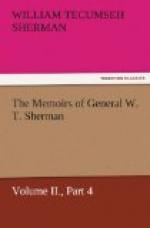CHAPTER XXI.
The march to the sea from Atlanta to Savannah.
November and December, 1864.
On the 12th of November the railroad and telegraph communications with the rear were broken, and the army stood detached from all friends, dependent on its own resources and supplies. No time was to be lost; all the detachments were ordered to march rapidly for Atlanta, breaking up the railroad en route, and generally to so damage the country as to make it untenable to the enemy. By the 14th all the troops had arrived at or near Atlanta, and were, according to orders, grouped into two wings, the right and left, commanded respectively by Major-Generals O. O. Howard and H. W. Slocum, both comparatively young men, but educated and experienced officers, fully competent to their command.
The right wing was composed of the Fifteenth Corps, Major-General P. J. Osterhaus commanding, and the Seventeenth Corps, Major-General Frank P. Blair commanding.
The left wing was composed of the Fourteenth Corps, Major-General Jefferson C. Davis commanding, and the Twentieth Corps, Brigadier-General A. S. Williams commanding.
The Fifteenth Corps had four divisions, commanded by Brigadier-Generals Charles R. Woods, W. B. Hazen, John E. Smith, and John M. Gorse.
The Seventeenth Corps had three divisions, commanded by Major-General J. A. Mower, and Brigadier-Generals M. D. Leggett and Giles A. Smith.
The Fourteenth Corps had three divisions, commanded
by
Brigadier-Generals W. P. Carlin, James D. Morgan,
and A. Baird.
The Twentieth Corps had also three divisions, commanded
by
Brigadier-Generals N. J. Jackson, John W. Geary, and
W. T. Ward.
The cavalry division was held separate, subject to my own orders. It was commanded by Brigadier-General Judson Kilpatrick, and was composed of two brigades, commanded by Colonels Eli H. Murray, of Kentucky, and Smith D. Atkins, of Illinois.
The strength of the army, as officially reported, is given in the following tables, and shows an aggregate of fifty-five thousand three hundred and twenty-nine infantry, five thousand and sixty-three cavalry, and eighteen hundred and twelve artillery in all, sixty-two thousand two hundred and four officers and men.
The most extraordinary efforts had been made to purge this army of non-combatants and of sick men, for we knew well that there was to be no place of safety save with the army itself; our wagons were loaded with ammunition, provisions, and forage, and we could ill afford to haul even sick men in the ambulances, so that all on this exhibit may be assumed to have been able-bodied, experienced soldiers, well armed, well equipped and provided, as far as human foresight could, with all the essentials of life, strength, and vigorous action.




